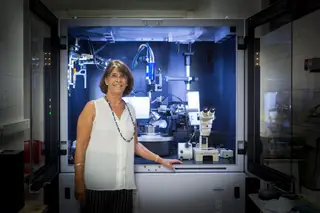Human beings have long made use of what they have learned from Nature for their own benefit. From yeast used to transform sugar into alcohol in the production of wine or beer, plants used for the production of biodiesel and compounds of plants and microorganisms isolated for their medicinal and other properties, humanity has enjoyed countless benefits from attributes found in other living beings.
A STABLE MOLECULE
Pursuant to the evolution of knowledge and the availability of means and equipment to enable this, the research and experimentation work conducted by scientists all over the world, aimed at gaining a better understanding of the processes of nature, has increased the number of discoveries. One of the most recent cases occurred in Portugal, and consisted of the study of a protein capable of capturing carbon dioxide from the air and reducing it to 'formate', a stable substance that can be used as fuel, for example.

Inês Cardoso Pereira highlights the importance of the discovery given the limited efficiency of current chemical catalysts in reducing CO2
Those carrying out this work, published in the specialty journal ACS Catalysis, Inês Cardoso Pereira, a full-time professor and deputy director of the António Xavier Institute of Chemical and Biological Technology at Nova University in Lisbon, and Maria João Romão, a full-time professor at the School of Sciences and Technology at the same university, emphasise that this is an important discovery due to the fact current chemical catalysts are not particularly efficient in reducing CO2, “a highly stable molecule. Moreover, “the reactions in which they are involved work in unfavourable conditions in terms of energy, as they occur at high temperatures and pressures, thereby giving rise to the formation of different types of products”, says Inês Cardoso Pereira. This is not the case with the process revealed in this study, in which “the proteins in question are very stable and remain active in normal conditions of pressure and temperature, resulting in just one product, 'formate'”.

Maria João Romão points out the existence of several studies that classify the possibility of using 'formate' as an alternative fuel as feasible.
It was based on this principle, geared to improving and increasing knowledge in relation to the process of reducing CO2 in the air and transforming it into other stable molecules, that Inês Cardoso Pereira and Maria João Romão began studying a process that occurs in plants and bacteria. The plant selected for the project, 'Desulfovibrio vulgaris', which served as a model, “is anaerobic, contains a large amount of proteins capable of removing CO2 and can be genetically modified to produce even more”, says Inês Cardoso Pereira. “The bacterium produces a protein, 'dehydrogenase formate', which is basically a catalyst for a reaction that will produce an alternative fuel, formate, from CO2”, adds Maria João Romão, stressing that knowledge of the atomic details of this protein will enable us to modify the enzyme and make it more effective. “This is one of our goals in terms of fundamental science and what we can do to develop a more efficient catalyst", she explains. ‘Formate’ is liquid, stable at ambient temperature and studies on its use as an alternative fuel are already underway. “The production of formate could be another alternative for dealing with CO2”, concludes Maria João Romão.
